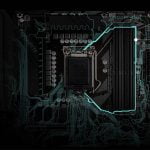These are our top picks as the best SSDs for Ryzen 5000 Processors.
Our recommended SSD is the Corsair MP600. But since people have different budgets, we have included other options too.
There was a time when an SSD was considered a luxury storage option- even in top-end systems.
But that time is long gone due to the ever-increasing storage size of AAA game titles and decreasing prices of SSDs.
Best SSDs For Ryzen 5000 Processors
Nowadays, if you want to fine-tune your gaming experience, you’ll need a good enough SSD as much as other PC components. Since these drives transfer data at a much faster speed when compared to hard drives, having your games stored in an SSDs slashes the loading time.
One big mistake many people do is that they pick 250GB SSD to be used as their boot-up drive for OS and then use an HDD for rest of the files. Yes, this approach can make your OS load faster but won’t help you much in gaming. That’s why we would advise you to store all of your games in the SSD as well.
And because AAA titles are getting as big as 100 GB these days, we would advise you to get at least 1 TB SSD if you’re using it as your main gaming storage. Another advantage SSDs have over hard drives is durability, since they don’t have any moving parts inside them.
1. AddLink S70: Best SSD for Ryzen 5 5600X and 5600G
- [Interface] PCIe Gen3x4 NVMe 1.3 3D TLC NAND interface; Perfect Upgrade For PC Builds & Laptops
- [Performance] Sequential Read/Write Speed Up To 3200/2600 MB/s (Performance Results Varies Based On System Hardware And Configuration). Note: read/write speed depend on the device, interface, usage and other factors so that actual performance may be lower.
- [Feature] Enhanced DRAM-Less Architecture With HMB. Supports SLC Cache, Optimized Performance And Enables Ultra-Low Power Consumption for Laptops & PCs.
AddLink is a relatively new player in the PC storage market but they have been a B2B company for a long time and have tried to enter the consumer market only recently. This is partly the reason why their S70 SSD is priced at just over 100 bucks despite having 1 TB capacity.
But this doesn’t mean that the quality is compromised here.
In terms of specs, S70 is the PCIe 3.0, four-lane NVMe SSD, is based on the 64-layer 3D TLC NAND process, and will fit into the M.2 slot of your Ryzen 5600X’s motherboard. In case you’re new to the SSDs, NVMe is the new standard for transferring data over the PCIe bus of the motherboard, and is very fast compared to the AHCI used by SATA SSDs.
On the other hand, NAND flash is the silicon chips that store the data. 3D TLC NAND is the successor of TLC NAND and is the latest NAND type used in SSDs.
Although it comes in 256GB, 512GB, 1TB, and 2TB capacity, we would recommend you 1TB version because of the higher TBW rating of 800. TBW rating is the number of terabytes you can write on an SSD before its cell start to fail.
Another reason why we prefer the 1TB storage here is that this version comes with 3000 MBps sequential write speed compared to 1000 MBps and 2000 MBps write speeds on 256GB and 512GB variants respectively. The read speed is better at 3400 MBps as well.
During our testing, it performed pretty close to top-end SSDs like Samsung 970 EVO Plus and don’t get too hot despite not coming with a heatsink.
It is a great option if you’re new to the SSD bandwagon. It has an excellent price and endurance rating and will give you probably value in terms of cost per Gigabyte.
The only shortcoming I could find is the lack of any management software and TLC write hole that comes at 20-25GB of continuous writing and subsequently performance dies. This performance depreciation occurs at 80GB in other top-end models.
It comes with a decent 5-year warranty which is good enough for most gamers.
2. WD Black SN750: Best SSD for Ryzen 7 5800X and 5700G
- An exclusive WD BLACK SSD dashboard with gaming mode improves game performance
- Non-heatsink model available in capacities ranging from 250GB to 4TB
- Ideal for enthusiasts building custom desktops or gaming rigs
Up next, we have SN750 by WD. It’s primarily targeted for laptops and high-end PCs.
Since Ryzen 5800X is a top-tier processor, both of them will complement each other. We particularly liked the 1 TB version because it would give you enough memory to do gaming as well as content creation.
It comes with WD’s SSD Toolbox Windows app that can help you tweak things in real-time. It has multiple tabs such as STATUS, PERFORMANCE, TOOLS, and SETTINGS, etc., which allows you to optimize the drive according to the taste.
This app also has a gaming performance toggle on the main screen. Once activated, this mode prevents the SN750 to go into low-performance mode and constantly pushes for a higher data transfer rate.
It causes more power consumption, though, and more heat production subsequently.
One advantage SN750 has over the likes of Addlink S70 is that it comes with a heatsink. This heatsink is developed by EKWB a well-known brand in PC custom cooling)
When it comes to PC hardware, the heat is a big turn-off from the performance point of view. So, if your motherboard doesn’t come with an M.2 slot heatsink, it’s worth investing in SN750.
During our time with it, the SN750 performed well in sequential read and write tests, but random read/write operations were slightly below that those of Samsung 970 Evo.
Like other top-end SSDs, it comes with a 5-year warranty and has a 600 TBW rating.
3. Corsair MP600: Best SSD For Ryzen 9 5900X And 5950X
- Extreme Gen4 Storage Performance: A PCIe Gen4 x4 controller delivers up to 4,950MB/s sequential read and 4,250MB/s sequential write speeds, for blazing fast read, write, and response times.
- High-speed Gen4 PCIe x4 NVMe M.2 Interface: Using PCIe Gen4 technology for maximum bandwidth, the MP600 delivers incredible storage performance.
- High-density 3D TLC NAND: Provides the ideal mix of performance, endurance, and value to keep your drive performing at its best for years.
One big advantage Ryzen 3000 and 5000 CPUs have over their intel counterparts is the PCIe 4.0 capability. PCIe is the interface on your motherboard and is used by PCIe slot components as well as M.2 drives.
PCIe 4.0 is the latest update of this standard that provides double speed when compared to the PCIe 3.0.
Graphics cards have not yet reached the peach limit of PCIe 3.0 standard, so it’s not quite useful for gaming alone. But if you’re into productive apps primarily, this faster data transfer rate is especially useful in SSDs where you can utilize it to ramp up your work.
For PCIe 4.o to work, you need a compatible motherboard and a PCIe 4.0 SSD. Since you most probably already have an x570 motherboard for Ryzen 5900X, the second thing you need is the PCIe 4.0 SSD, for which we have picked the Corsair MP600.
Many people associate Corsair with gaming mice and keyboards only, but they make excellent PC components too and we love their power supplies and liquid coolers specifically.
Coming back to MP600, it looks exactly like other M.2 2280 SSDs except for the fact that it has a black-colored heatsink cover. With maximum theoretical read/write speeds of 4950/4200 MBps (for 1TB version), MP600 is the fastest consumer SSD you can have right now.
It comes with a management software in the form of Corsair SSD Toolbox as well which allows you to do Secure Erase, manual over-provisioning, and auto-scheduling of TRIM operation, etc.
Another advantage it has over the competition is the enormous 1800 TBW rating which makes everything else pale in comparison because most of them are limited to the 800-1200 TBW range.
The warranty is relatively balanced against what other SSDs offer: 5 years.
At 1TB, it’s almost $35 expensive than many PCIe 3.0 SSDs available, and that is probably the only downside you can have with MP600.
On the other hand, it comes with a large written cache and an attractive design with the heatsink. And since more PCIe 4.0 enabled hardware will roll out in the coming years, it’s surely a worthy investment for your new 5900x/5950X powered system.
Conclusion
So these were some of our recommended SSDs for Ryzen 5000 processors. Some other options could’ve been mention above such as Samsung 970 Evo/Plus, but we decided to have as minimum SSDs as possible.
So that you do not feel overwhelmed by a lot of options.






